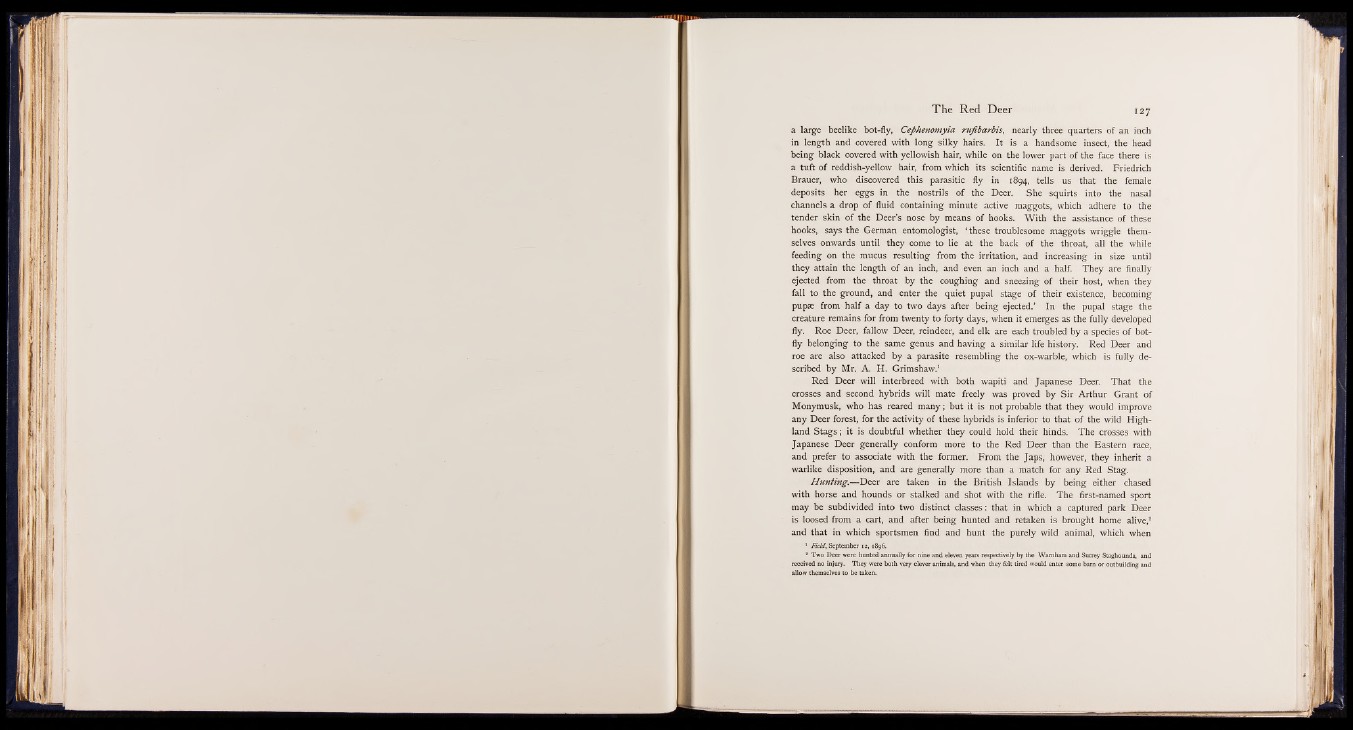
a large beelike bot-fly, Cephenomyia rufibarbis, nearly three quarters of an inch
in length and covered with long silky hairs. It is a handsome insect, the head
being black covered with yellowish hair, while on the lower part of the face there is
a tuft of reddish-yellow hair, from which its scientific name is derived. Friedrich
Brauer, who discovered this parasitic fly in 1894, tells us that the female
deposits her eggs in the nostrils of the Deer. She squirts into the nasal
channels a drop of fluid containing minute active maggots, which adhere to the
tender skin of the Deer’s nose by means of hooks. With the assistance of these
hooks, says the German entomologist, ‘ these troublesome maggots wriggle themselves
onwards until they come to lie at the back of the throat, all the while
feeding on the mucus resulting from the irritation, and increasing in size until
they attain the length of an inch, and even an inch and a half. They are finally
ejected from the throat by the coughing and sneezing of their host, when they
fall to the ground, and enter the quiet pupal stage of their existence, becoming
pupae from half a day to two days after being ejected.’ In the pupal stage the
creature remains for from twenty to forty days, when it emerges as the fully developed
fly. Roe Deer, fallow Deer, reindeer, and elk are each troubled by a species of botfly
belonging to the same genus and having a similar life history. Red Deer and
roe are also attacked by a parasite resembling the ox-warble, which is fully described
by Mr. A. H. Grimshaw.1
Red Deer will interbreed with both wapiti and Japanese Deer. That the
crosses and second hybrids will mate freely was proved by Sir Arthur Grant of
Monymusk, who has reared many; but it is not probable that they would improve
any Deer forest, for the activity of these hybrids is inferior to that of the wild Highland
S tags ; it is doubtful whether they could hold their hinds. The crosses with
Japanese Deer generally conform more to the Red Deer than the Eastern race,
and prefer to associate with the former. From the Japs, however, they inherit a
warlike disposition, and are generally more than a match for any Red Stag.
Hunting.— Deer are taken in the British Islands by being either chased
with horse and hounds or stalked and shot with the rifle. The first-named sport
may be subdivided into two distinct classes: that in which a captured park Deer
is loosed from a cart, and after being hunted and retaken is brought home alive,2
and that in which sportsmen find and hunt the purely wild animal, which when
1 Field, September 12,1896.
2 Two Deer were hunted annually for nine and eleven years respectively by the Wamham and Surrey Staghounds, and
received no injury. They were both very clever animals, and when they felt tired would enter some barn or outbuilding and
allow themselves to be taken.